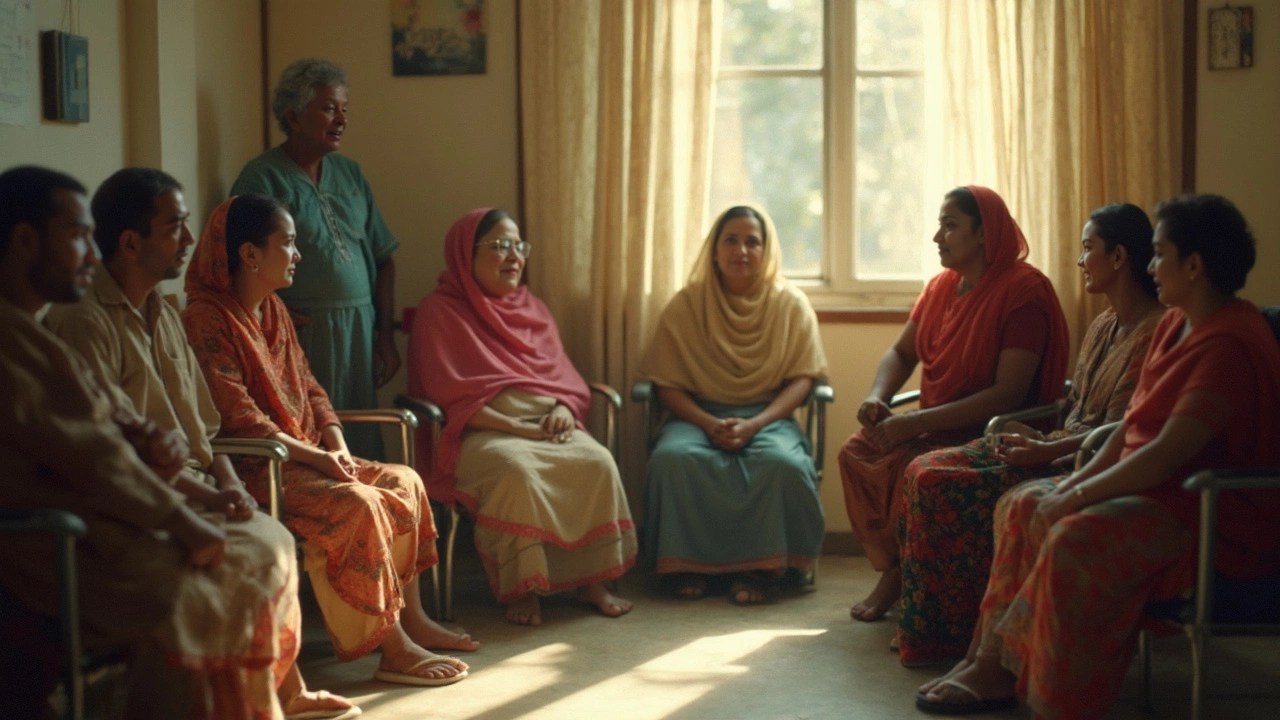Most folks think beating cancer means it's gone for good, like a bad cold that finally left the building. But it's not that simple. Doctors rarely say someone is 'cured'—instead, they use words like 'remission' or 'no evidence of disease.' Those terms sound pretty hopeful, but there's a reason they stick to them.
See, cancer can be sneaky. Even if it vanishes from scans or blood tests, a few cells might hide out in the body, waiting for a chance to come back. That’s why some people ring the victory bell, only to have cancer make a comeback years later. It’s normal to have questions: ‘Am I really safe now?’ ‘Should I keep worrying?’ Those feelings are valid. And if you’ve ever seen a loved one go through it—like watching my own daughter jump through every little cold after my treatments—you know how that worry lingers.
So, can you truly beat cancer? The answer depends on the type of cancer, your unique body, and a fair bit of luck. But with early treatment, good follow-up, and some lifestyle changes, people today are living longer and better than ever after a cancer diagnosis. The key? Stay informed, pay attention to your body, and keep routine checkups—even after the main treatments end.
- Remission versus Cure: What's the Difference?
- Why Does Cancer Come Back?
- What Improves Your Chances?
- Living After Cancer: Real-Life Tips
Remission versus Cure: What's the Difference?
People toss around the words ‘remission’ and ‘cure’ like they’re basically the same, but they aren’t. In the world of cancer treatment, doctors pick their language carefully because, honestly, there’s no simple finish line.
Remission means the signs and symptoms of cancer have reduced or disappeared. For some, it’s a total wipeout—you can’t find cancer anywhere. For others, the disease just shrinks or gets quieter but doesn’t totally leave. Either way, you’re not out of the woods. Regular check-ups and tests keep you and your doctor on alert.
Cure is tougher to claim. In the cancer world, 'cured' usually means you’ve stayed cancer-free long enough (often five years or more) that the odds of cancer coming back are tiny. But even after that mark, some cancers can return, which is why you’ll almost never hear an oncologist promise an official cure. It’s not about being negative—it’s about being real with the risks.
Here’s a quick look at what these terms actually mean, and the numbers behind them:
| Term | What It Means | Can Cancer Come Back? |
|---|---|---|
| Remission | No signs of cancer, but still possible tiny amounts in your body | Yes |
| Cure | No return after five years or more; considered gone | Rare, but possible |
Some cancers, like testicular cancer or Hodgkin lymphoma, have high cure rates—up to 90% if caught early. Other cancers, such as pancreatic or late-stage lung cancer, are much less likely to truly disappear for good. Doctors rely on survival rates, usually measured at five years after diagnosis, to track progress. For example:
- Early-stage breast cancer: about 90% five-year survival rate
- Early prostate cancer: over 95%
- Advanced pancreatic cancer: under 10%
It’s easy to fixate on the word ‘cure,’ but focusing on remission and living well post-treatment can lower anxiety and help you stay on top of your health. Your doctor isn’t dodging your question—they’re protecting you from false hopes and keeping things straight about what’s really going on inside your body.
Why Does Cancer Come Back?
It’s a gut-punch to go through treatment and then hear your cancer treatment didn’t finish the job. So, what gives? Cancer coming back isn’t your fault, and it doesn’t mean doctors made a mistake. The real reason often comes down to the nature of cancer cells—they’re tough, slippery, and can survive even heavy-duty treatments.
Sometimes, a few cancer cells hang around after chemo, radiation, or surgery. These cells are tiny, and almost impossible to spot on scans. They find a quiet place, sit tight, and can wake up months or even years later. That’s called recurrence, and it’s more common than most people think. Here’s a quick look at why it might happen:
- Some cancer cells are naturally resistant to drugs or radiation. Treatments kill the easy targets, but the tougher cells can survive and multiply.
- Cancer spreads (metastasizes) before anyone notices symptoms. A stray group of cells can hide in another organ from the very start.
- Our immune systems sometimes miss these sneaky cells. Even when tests say "all clear," that doesn’t always mean every cancer cell is gone.
It helps to see some numbers. According to major studies, recurrence rates depend a lot on cancer type, stage, and treatment. Here’s a quick peek at how common it really is for cancers to come back within 5 years:
| Cancer Type | Average 5-Year Recurrence Rate |
|---|---|
| Breast (early stage) | 10-20% |
| Colon (stage II/III) | 20-30% |
| Ovarian | 70-85% |
| Lung (non-small cell, after surgery) | 30-55% |
It’s wild to realize just how much it varies. Your doctor looks at your specific numbers—like stage and type—to predict the odds and help make the best plan. What really matters: getting regular checkups, not ignoring weird symptoms, and speaking up if something doesn’t feel right. That’s what stacks the odds in your favor the most.

What Improves Your Chances?
If you’re wondering what actually gives you a better shot at beating cancer, the answer isn’t just luck. There are real, proven things you can do that make a difference. Some are about medical care, others are daily habits that you control.
- Cancer treatment works best when cancer is caught early. Regular screenings matter—like mammograms for breast cancer or colonoscopies for colon cancer. Early diagnosis gives doctors more options and usually means less harsh treatment.
- Following treatment plans is huge. Yep, those chemo or radiation appointments you want to skip or the pills your doctor keeps nagging about? They really matter. Sticking to the plan improves your odds of staying in remission.
- Your health going into treatment counts. The better shape your body’s in, the stronger you are for fighting side effects and bouncing back. Even simple walks or basic stretching help.
- Making good lifestyle changes helps more than you might think. A healthy diet (think fruits, veggies, lean meats), keeping a healthy weight, not smoking, and going easy on alcohol are biggies.
- Don’t skip follow-up checks. Even when you feel fine, these catch any trouble early—sometimes before symptoms pop up.
- Mental health isn’t just fluff. Managing stress, asking for help, or talking to a coach or therapist makes treatments easier to handle—and can improve recovery.
Here’s a quick look at reported survival rates for a few common cancers when caught early versus late:
| Cancer Type | Early Stage (5-Year Survival %) | Late Stage (5-Year Survival %) |
|---|---|---|
| Breast | 99% | 30% |
| Colorectal | 91% | 15% |
| Lung | 65% | 8% |
Those numbers are real and show why catching it early and sticking with treatment changes everything.
Living After Cancer: Real-Life Tips
No one really explains how weird and upside down life can get after cancer treatment. There's a lot of pressure to "get back to normal," but what does that even mean now? For a lot of people, the new normal means regular checkups, being extra aware of every ache and pain, and figuring out how to handle tiredness that just lingers.
Here are some practical tips that help real people stay on top of life after cancer treatment:
- Keep all follow-up appointments: Even if you feel fine, those regular check-ins help spot any changes early. Most doctors recommend checkups every 3–6 months in the first couple of years.
- Know your body's "new normal": It’s not unusual to have side effects like fatigue, "chemo brain," or changes in appetite. Track your symptoms and don’t ignore anything that feels odd.
- Don’t skip screenings: You’re at higher risk for some cancers after certain treatments, so get those mammograms, colonoscopies, or blood tests as your doctor suggests.
- Move your body, even a little: Studies in the U.S. (like the big 2022 ACS report) show just 150 minutes of moderate movement a week—think brisk walking—can cut recurrence risk in some cancers.
- Fuel up with the good stuff: Focus on lean protein, fruits, veggies, and whole grains. A 2024 research update found plant-heavy diets reduce cancer recurrence in breast and colon cancer survivors.
- Talk about your mental health: Anxiety and depression are way more common after cancer. Groups, counselors, or even honest chats with friends can make a world of difference.
- Update your health records: Keep a copy of your treatment summary—sometimes called a "survivorship care plan"—and make sure your primary doctor has it too. This helps avoid confusion if you see new docs later on.
What about the odds? Here’s a quick look at follow-up and recurrence numbers for common cancers:
| Cancer Type | 5-Year Survival Rate | Usual Follow-Up Schedule (First 2 Years) | Typical Recurrence Risk |
|---|---|---|---|
| Breast | 90% | Every 3–6 months | 15–25% |
| Colon | 65% | Every 3–6 months | 30–40% |
| Prostate | 98% | Every 6 months | 10–30% |
| Lung | 27% | Every 3–6 months | 30–50% |
If you’re helping a kid or loved one adjust, little routines matter. My daughter Maya still reminds me to pack my meds, and we celebrate clear scans with her favorite pizza. If setbacks happen, just keep moving forward. Life after cancer is never quite the same, but with a solid plan and realistic support, it can still be really good.
